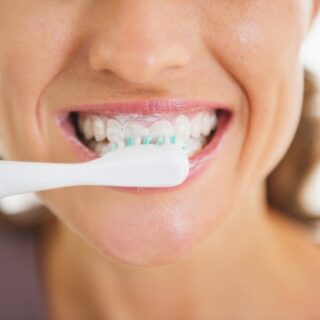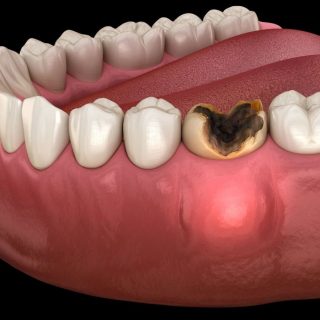Healthy gums are the foundation of a healthy smile, yet they’re often overlooked in daily oral care. While many people focus on brushing to prevent cavities, gum problems often develop quietly and without pain, making them easy to miss until they become serious. Neglecting gum health can lead to issues such as gum recession, infection, bone loss, or even tooth loss. Fortunately, gum health can be protected and even improved with the right habits. By following simple tips for healthy gums as part of your daily routine combined with professional care when needed, you can keep both your gums and teeth strong for years to come.
The connection between healthy teeth and gums
Teeth and gums work together as a team. Strong gums provide the foundation that keeps teeth stable and supported, while healthy teeth help prevent the gums from infection, irritation, and further damage. If we neglect either side, the other side will surely suffer.
For example, cavities that remain untreated, along with plaque and tartar buildup on teeth can spread bacteria into the gums that cause inflammation and gum disease. Conversely, weak or receding gums expose the roots of your teeth, resulting in more sensitivity, increased risk for decay, and loosening of teeth.
This close relationship means that good oral care should never focus on just teeth or just gums. A complete routine protects both, ensuring long-term oral health and a confident smile.
Common warning signs of unhealthy gums
Gum problems often start silently, but your mouth usually gives you early signals that something isn’t right. Recognizing these signs can help you take action before issues progress into serious gum disease. Some of the most common warning signs include:
- Persistent bad breath or an unpleasant taste that doesn’t go away after brushing or rinsing.
- Bleeding gums, especially when brushing or flossing.
- Swollen, red, or tender gums that feel sore to the touch.
- Gums pulling away from the teeth, making them appear longer.
- Teeth that are loose or moving could be an indication of weakened gum support.
10 ways to keep your teeth healthy
- Brush daily: Consistent brushing, 2- 3 times per day, removes food particles and plaque before they harden into tartar.
- Use fluoride toothpaste: Fluoride helps strengthen tooth enamel and prevents cavities.
- Change your toothbrush regularly: Replace your toothbrush every 3–4 months to keep it effective.
- Brush the right way: Use gentle, circular motions instead of harsh scrubbing to clean thoroughly without damaging enamel or gums.
- Use floss to clean in between your teeth: Plaque and debris that a toothbrush cannot reach should be removed by cleaning in between teeth.
- Maintain a balanced diet: Limit sugary snacks and include nutrient-rich foods that support teeth and gum strength.
- Avoid tobacco: Tobacco use through either smoking or chewing tobacco can further increase the risk of gum disease, oral cancer, and tooth staining.
- Visit dentist regularly: Regular dental checkups are key to spotting any issues early on and keeping your teeth and gums healthy
- Rinse or drink water after meals: Water helps wash away food particles and neutralize acids that can harm enamel.
- Watch for any warning signs: Sensitivity, pain, or bleeding gums are signals that should never be ignored.
Dietary tips for healthy gums
What you eat plays a direct role in how strong and resilient your gums remain. Certain foods nourish gum tissue, fight inflammation, and help keep harmful bacteria under control. Here are some of the best dietary choices for healthier gums:
- Fatty fish: Salmon, mackerel, and sardines are rich in omega-3 fatty acids, which reduce inflammation and support the body’s ability to fight gum disease.
- Nuts and seeds: Almonds, walnuts, and chia seeds are rich sources of healthy fats and nutrients that help fortify both teeth and gums.
- Dairy products: Milk, cheese, and yogurt are loaded with calcium and proteins that help strengthen your teeth and keep your gum tissue healthy.
- Probiotic-rich foods: Yogurt, kefir, sauerkraut, and kimchi supply good bacteria that help balance the mouth’s microbiome and reduce harmful bacterial growth.
- Green tea: Packed with antioxidants like catechins, green tea reduces inflammation and helps fight bacteria linked to gum disease.
- Fruits and vegetables: Such as oranges, strawberries, bell peppers, and leafy greens provide Vitamin C and powerful antioxidants that enhance immunity and aid in gum recovery.
How to strengthen gums naturally: 5 daily habits
- Practice good oral hygiene: Brush gently along the gumline twice a day and floss daily to remove plaque and food particles that can irritate gums.
- Use an antibacterial mouthwash: Rinsing with a therapeutic mouthwash helps reduce harmful bacteria, control plaque, and ease inflammation.
- Stay hydrated: Staying well-hydrated helps your body make more saliva, which is great for washing away bacteria and keeping your gums moist, protecting them naturally.
- Eat gum-supporting foods: Include nutrient-rich options like citrus fruits, leafy greens, fatty fish, and nuts to supply vitamins and minerals that strengthen gum tissue.
- Avoid tobacco and irritants: Smoking and chewing tobacco damage gum tissue and slow healing, while other irritants can worsen gum problems.
Effective treatments for gum disease
Treatment of gum disease depends on the severity of the problem. Mild gum problems can often be reversed with better home care and regular cleanings, while more serious problems may need deeper cleanings, medication, or even surgery.
Some of the most common treatment options:
- Professional Cleaning & Better Hygiene: In mild cases such as gingivitis, routine dental cleanings combined with daily brushing and flossing can restore gum health before permanent damage occurs.
- Scaling and Root Planing: A deeper cleaning that removes plaque and bacteria beneath the gumline and smooths tooth roots to help gums reattach.
- Antibiotic Therapy: Topical or oral antibiotics may be used to reduce bacterial infection and support healing.
- Flap (Pocket Reduction) Surgery: For advanced gum disease, the gums are carefully lifted to remove tartar deep below the surface, then repositioned to reduce pocket depth.
- Gum and Bone Grafting: Replacing lost tissue or bone helps strengthen support around the teeth and improve gumline appearance.
- Laser Therapy: In some cases, lasers are used to remove diseased tissue with less discomfort and faster healing compared to traditional surgery.
While these treatments focus on restoring gum health, some procedures are also designed to enhance appearance. For instance, cosmetic options like gummy smile correction without surgery can reshape the gumline to create a more balanced and confident smile.
El-Shenawy Dental Centers: advanced gum disease treatments
While daily care and simple tips for healthy gums are extremely helpful in preventing issues, advanced stages of gum disease often require professional treatment. At El-Shenawy Dental Centers, the patient gets complete care with modern techniques and advanced technology to help improve their gum health and protect their long-term oral function.
From deep cleaning and scaling to surgical options, the clinics provide individual treatment plans based on the needs of each patient. With a team of experienced specialists and a commitment to patient comfort, El-Shenawy Dental Centers ensure that gum problems are managed effectively and future issues are prevented.
Protect your smile with advanced gum care at El-Shenawy Dental Centers. Book your consultation today.
Frequently asked questions
-
Can I treat gum disease at home?
No, gum disease cannot be fully treated at home. Good oral hygiene, like brushing, flossing, and using mouthwash, can help manage the early stage (gingivitis), but once the disease progresses, professional treatment is necessary to remove deep plaque and bacteria.
-
Is gum bleeding normal while brushing?
No, this is not normal. Occasional bleeding may happen if you’re brushing too hard, but consistent bleeding is often an early warning sign of gum disease and should not be ignored.
-
Can gums grow back after receding?
No. Gum tissue that has receded cannot grow back on its own. However, professional treatments such as gum grafting can restore coverage and protect exposed roots.



















